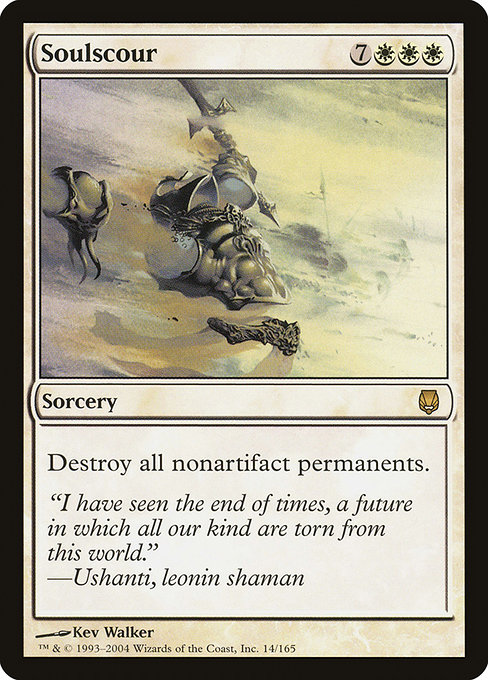
Image courtesy of Scryfall.com
Innovation risks in Soulscour’s card design
Magic: The Gathering’s designers often walk a tightrope between making something new and keeping the game approachable. Soulscour, a rare white sorcery from Darksteel (DST), stands as a case study in balancing power, color identity, and set theme. With a mana cost of seven generic and three white mana ({7}{W}{W}{W}), Soulscour embodies a bold, high-impact effect: destroy all nonartifact permanents. That’s not just a board wipe; it’s a deliberate architectural choice that honors White’s role as purification and cleansing on the battlefield 🧙🔥💎⚔️. The risk here is twofold: first, does the card overwhelm the board state by removing more than half of what a player controls, and second, how does that interact with Darksteel’s artifact-heavy world?
The design core: timing, cost, and the artifact exception
At first glance, spending 10 mana to erase everything that isn’t an artifact feels prohibitively expensive in most formats. Yet the payoff—an immediate, all-in reset that leaves artifacts standing—fits a particular archetype: a world where artifacts are the engine and the artifact-only permanence becomes the lasting fortress. The nonartifact clause is the crux of the risk. It creates a stark dichotomy: if your opponent has loaded artifacts, you’re not necessarily wiping the board clean; you’re carving out a path to leverage your artifacts’ resilience. In a Darksteel environment, where indestructible and artifact themes are prominent, Soulscour invites creative deck-building around timing and board state. The card’s rarity—rare—reflects a targeted power spike, and it’s a reminder that danger often hides in elegance: the simpler the text, the deeper its strategic footprint. In practice, this design nudges players toward recognizing when a wipe is worth the wait. If your opponent has a critical suite of artifacts, Soulscour will wipe away their nonartifact threats while sparing those precious tools. That makes it a strategic pivot for artifact-centric decks, especially in formats where color-pie balance is key. The price tag also signals that the card is not a one-off blow but a deliberate, situational answer that requires proper setup and timing — a hallmark of thoughtful innovation rather than brute force 🧙🔥🎲.
Flavor, art, and the ethos of Confluence
“I have seen the end of times, a future in which all our kind are torn from this world.” — Ushanti, leonin shaman
The flavor text anchors Soulscour in a mythic, high-stakes moment. The looming inevitability hinted at in Ushanti’s line elevates the card from a mere mechanical effect to a narrative beat: cleansing the battlefield is a moral and existential choice, one that can swing the future of a game, a match, or even a legend. Kev Walker’s artwork—undoubtedly bold in the Darksteel frame—evokes a radiance that feels both divine and ominous, a visual cue that white mana might be purifying, but it also costs something precious whenever the spell resolves. This is design that sings in color, not just text 🖌️🎨.
Strategic takeaway: when to cast Soulscour
For players who lean into artifact synergy or who relish interactions with Armor of Ancients, Vaulted Relics, or other artifact-laden boards, Soulscour asks a patient question: is the destruction of nonartifact permanents worth the ten-mana investment? In legacy and vintage, where access to mana acceleration and tutoring is common, you can imagine a world where a well-timed Soulscour resets a battlefield crowded with nonartifact threats while preserving your artifact-based engines. In commander (or EDH), Soulscour becomes a dramatic late-game option—if you’ve built around artifacts and have ways to accelerate your mana, the spell can pivot from “big game ender” to “season-changing tempo swing” with the right setup 🧙🔥⚔️. In contrast, modern playstyles usually see this card as a historical curiosity or a niche finisher given its cost and conditions. The innovation risk here is clear: a design that works beautifully in artifact ecosystems must still contend with power level and format viability, lest it feel like a missed opportunity or a trap for weak board states 🎲.
Value, collectibility, and the collector’s mindset
Darksteel remains a beloved era for many MTG fans, with its focus on artifacts and a robust vintage presence. Soulscour’s rarity, combined with the set’s enduring artifact aesthetic, has helped it sustain niche value in nonfoil and foil forms. According to market snapshots, the card’s price hovers a few dimes to dollars in common play, with foil variants commanding higher figures for collectors—an echo of its status as a legacy piece rather than a standard-legal staple. For players who chase nostalgia or invest in the long arc of card design history, Soulscour is a standout example of a high-cost, high-concept effect that still sparks debate about balance and risk in white’s purifying toolkit. The narrative around Soulscour is as much about design philosophy as it is about board states, and that makes it a prized artifact in any serious collection 🧙🔥💎.
Art, lore, and the future of heavy-hitting white wipes
As designers continue to push the envelope on board wipes, Soulscour serves as a reminder that innovation flourishes when a card’s text carries weight and its mechanics speak to a larger set theme. White’s identity includes not only removal and protection but also the ethical dimension of “what must be removed” to restore balance. The Darksteel era, with its bold artifact-forward design, invites players to think about how artifacts can anchor a game plan and how wipes can be tuned to honor that tension. For fans of the multiverse who savor the blend of strategy, story, and artistry, Soulscour is a compelling case study—one that pairs scholarly risk assessment with the thrill of a dramatic moment on the battlefield 🧙🔥🎨.